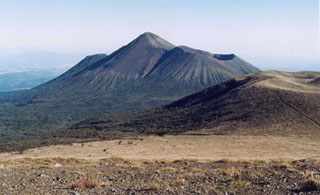Report on Kirishimayama (Japan) — 26 January-1 February 2011
Smithsonian Institution / US Geological Survey
Weekly Volcanic Activity Report, 26 January-1 February 2011
Managing Editor: Sally Sennert.
Please cite this report as:
Global Volcanism Program, 2011. Report on Kirishimayama (Japan) (Sennert, S, ed.). Weekly Volcanic Activity Report, 26 January-1 February 2011. Smithsonian Institution and US Geological Survey.
Kirishimayama
Japan
31.934°N, 130.862°E; summit elev. 1700 m
All times are local (unless otherwise noted)
According to the Earthquake Research Institute, an explosion on 26 January from Shinmoe-dake (Shinmoe peak), a stratovolcano of the Kirishima volcano group, prompted JMA to raise the Alert Level to 3 (on a scale of 1-5). Lightning in the ash plume was visible in video footage that same day. Based on reports from JMA, analyses of satellite imagery, and pilot observations, the Tokyo VAAC reported that during 26-27 January ash plumes rose to altitudes of 1.8-2.1 km (6,000-7,000 ft) a.s.l. and drifted SE. According to news articles, tephra fell as far away as 8 km on 27 January and disrupted airline and train services. Some people in Miyazaki (55 km E) voluntarily evacuated and approximately 30 people in Takaharu (15 km E) spent the night in an evacuation center. Video footage showed people clearing ash from the streets.
During an overflight on 29 January, scientists observed a new lava dome in the crater, about 50 m in diameter and incandescent in some areas. They also observed that the crater lake was gone and pyroclastic-flow deposits, 500-600 m long, were present in the SW crater. Notices issued from the Tokyo VAAC during 28-30 January stated that ash emissions were continuing. On 31 January, an ash plume rose to an altitude of 2.1 km (7,000 ft) a.s.l. and drifted SE. A news article noted that an explosion on 1 February was heard more than 7 km away, and broke glass in buildings and cars as far as 8 km away.
Geological Summary. Kirishimayama is a large group of more than 20 Quaternary volcanoes located north of Kagoshima Bay. The late-Pleistocene to Holocene dominantly andesitic group consists of stratovolcanoes, pyroclastic cones, maars, and underlying shield volcanoes located over an area of 20 x 30 km. The larger stratovolcanoes are scattered throughout the field, with the centrally located Karakunidake being the highest. Onamiike and Miike, the two largest maars, are located SW of Karakunidake and at its far eastern end, respectively. Holocene eruptions have been concentrated along an E-W line of vents from Miike to Ohachi, and at Shinmoedake to the NE. Frequent small-to-moderate explosive eruptions have been recorded since the 8th century.
Sources: BBC News, Tokyo Volcanic Ash Advisory Center (VAAC), Japan Today, Agence France-Presse (AFP), Volcano Research Center-Earthquake Research Institute (University of Tokyo)

